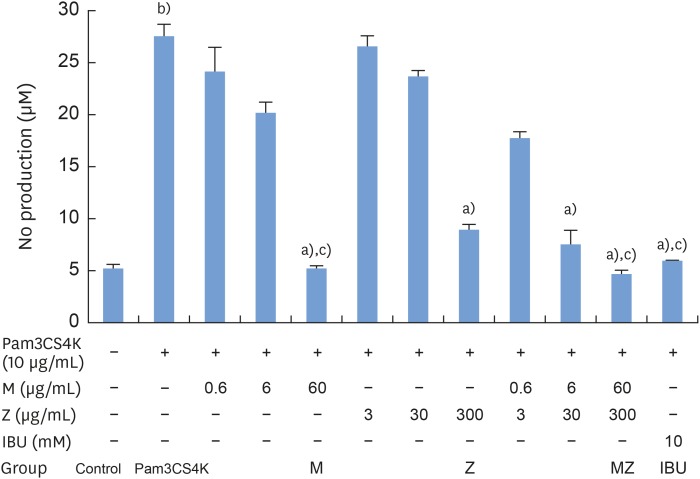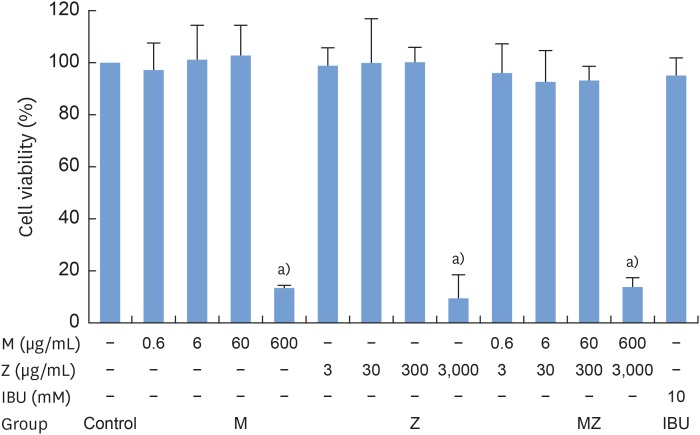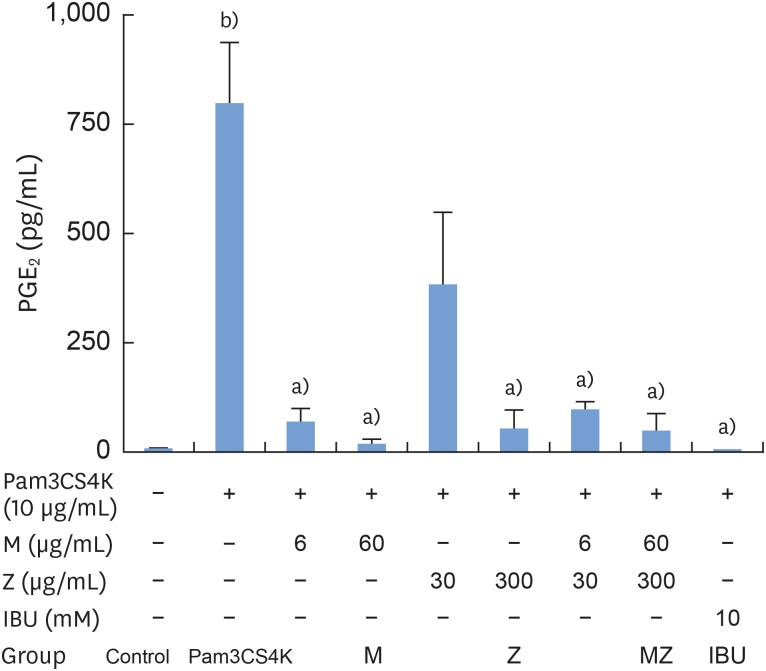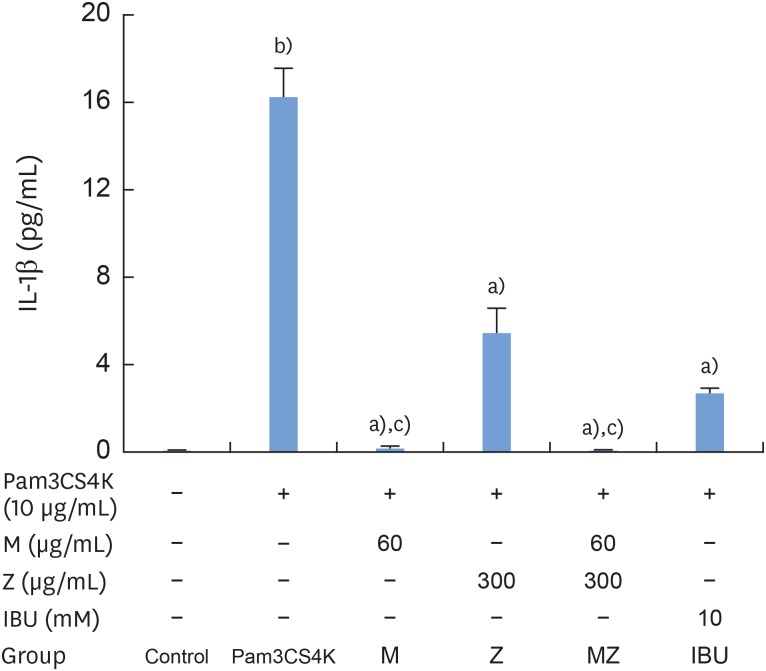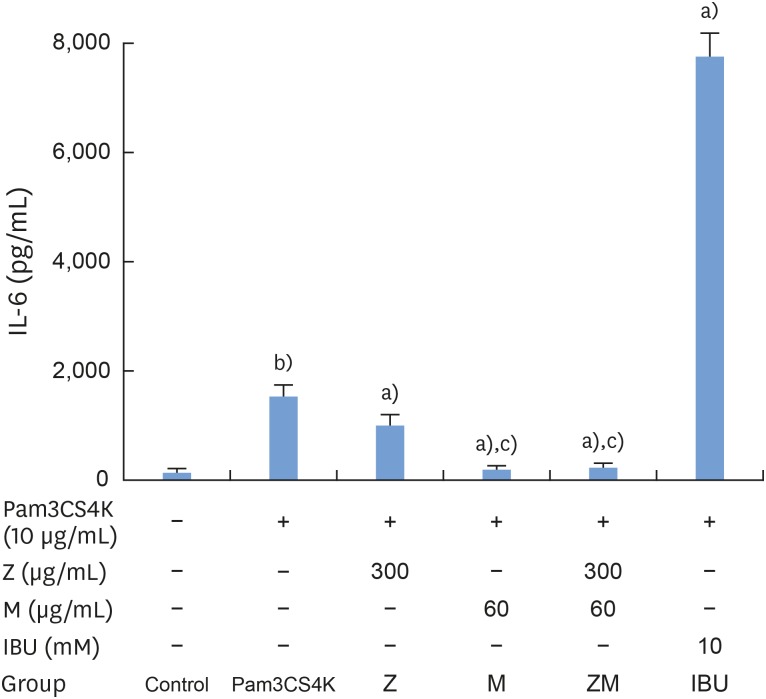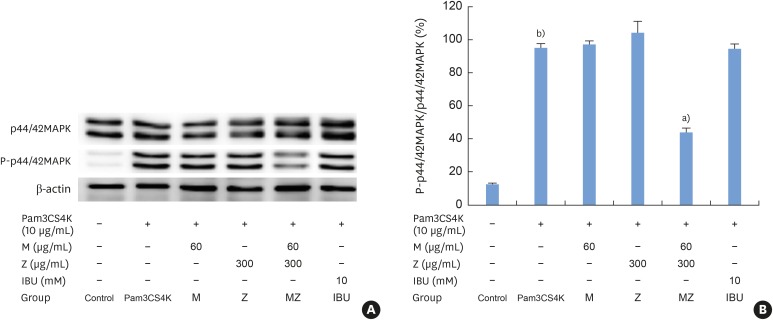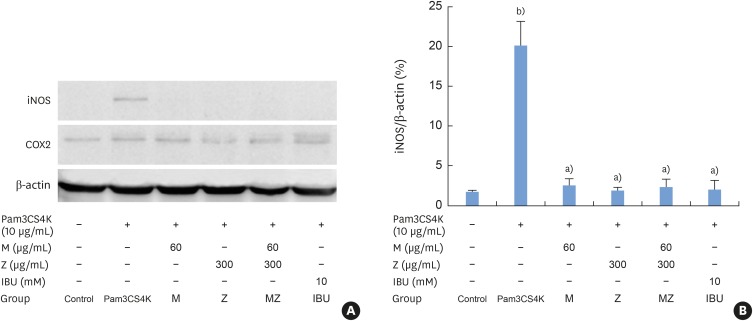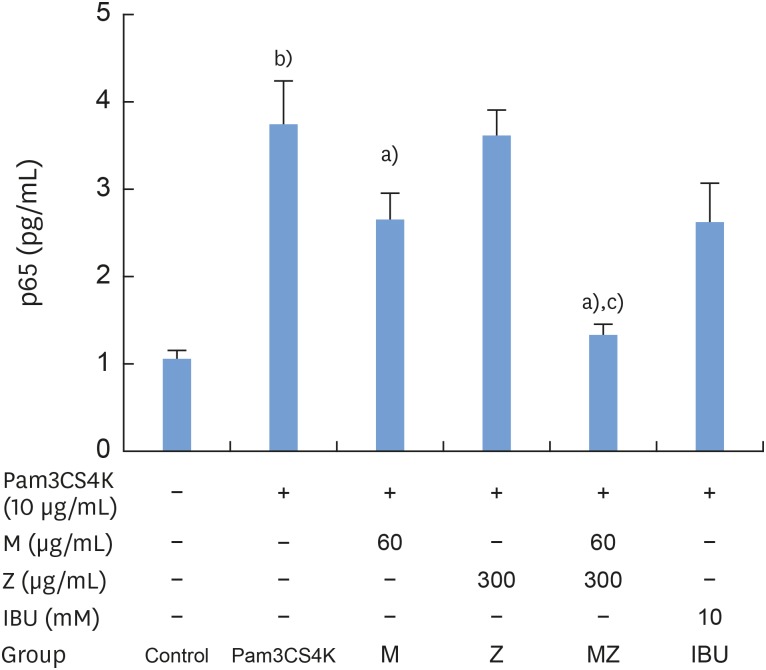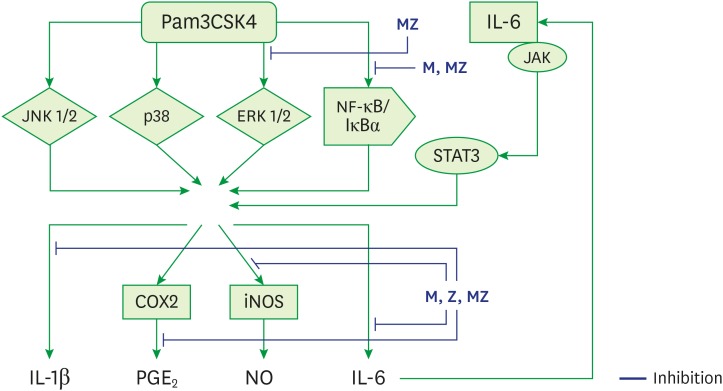J Periodontal Implant Sci.
2018 Apr;48(2):70-83. 10.5051/jpis.2018.48.2.70.
Magnoliae Cortex and maize modulate Porphyromonas gingivalis-induced inflammatory reactions
- Affiliations
-
- 1Department of Periodontology, Dental Research Institute, Seoul National University School of Dentistry, Seoul, Korea. icrhyu@snu.ac.kr
- KMID: 2410686
- DOI: http://doi.org/10.5051/jpis.2018.48.2.70
Abstract
- PURPOSE
The aim of this study was to evaluate the capacity of single and combined applications of the bark of the stems and roots of Magnolia officinalis Rehd. et Wils. (Magnoliae Cortex) and Zea mays L. (maize) to modulate inflammation in RAW 264.7 cells stimulated with Porphyromonas gingivalis.
METHODS
RAW 264.7 cells were stimulated with P. gingivalis, and Magnoliae Cortex and/or maize was added. Cytotoxicity and the capacity to modulate inflammation were determined with a methylthiazol tetrazolium (MTT) assay, nitrite production, enzyme-linked immunosorbent assay (ELISA), and western blotting.
RESULTS
Treatment with Magnoliae Cortex and/or maize inhibited nuclear transcription factor κB (NF-κB) pathway activation and nuclear p44/42 mitogen-activated protein kinase (MAPK) and inducible nitric oxide synthase (iNOS) protein expression in P. gingivalis-stimulated RAW 264.7 cells. Moreover, the treatments suppressed cytokines (prostaglandin E2 [PGE2], interleukin [IL]-1β, and IL-6) and nitrite production.
CONCLUSIONS
Both Magnoliae Cortex and maize exerted an anti-inflammatory effect on P. gingivalis-stimulated RAW 264.7 cells, and this effect was more pronounced when the extracts were combined. These findings show that these extracts may be beneficial for slowing the progression of periodontal disease.
Keyword
MeSH Terms
-
Blotting, Western
Cytokines
Enzyme-Linked Immunosorbent Assay
Inflammation
Interleukins
Magnolia*
Mitogen-Activated Protein Kinase 3
Nitric Oxide Synthase Type II
Periodontal Diseases
Porphyromonas gingivalis
Porphyromonas*
Protein Kinases
RAW 264.7 Cells
Transcription Factors
Zea mays*
Cytokines
Interleukins
Mitogen-Activated Protein Kinase 3
Nitric Oxide Synthase Type II
Protein Kinases
Transcription Factors
Figure
Reference
-
1. Socransky SS, Haffajee AD. The bacterial etiology of destructive periodontal disease: current concepts. J Periodontol. 1992; 63(Suppl 4S):322–331.
Article2. Yağan A, Kesim S, Liman N. Effect of low-dose doxycycline on serum oxidative status, gingival antioxidant levels, and alveolar bone loss in experimental periodontitis in rats. J Periodontol. 2014; 85:478–489. PMID: 23786405.
Article3. Nibali L. Aggressive periodontitis: microbes and host response, who to blame? Virulence. 2015; 6:223–228. PMID: 25654663.
Article4. Paquette DW, Williams RC. Modulation of host inflammatory mediators as a treatment strategy for periodontal diseases. Periodontol 2000. 2000; 24:239–252. PMID: 11276870.
Article5. Zawawi KH, Kantarci A, Schulze-Späte U, Fujita T, Batista EL Jr, Amar S, et al. Moesin-induced signaling in response to lipopolysaccharide in macrophages. J Periodontal Res. 2010; 45:589–601. PMID: 20546116.
Article6. Liang YC, Huang YT, Tsai SH, Lin-Shiau SY, Chen CF, Lin JK. Suppression of inducible cyclooxygenase and inducible nitric oxide synthase by apigenin and related flavonoids in mouse macrophages. Carcinogenesis. 1999; 20:1945–1952. PMID: 10506109.
Article7. Müller JM, Ziegler-Heitbrock HW, Baeuerle PA. Nuclear factor kappa B, a mediator of lipopolysaccharide effects. Immunobiology. 1993; 187:233–256. PMID: 8330898.
Article8. Hsu HY, Hua KF, Wu WC, Hsu J, Weng ST, Lin TL, et al. Reishi immuno-modulation protein induces interleukin-2 expression via protein kinase-dependent signaling pathways within human T cells. J Cell Physiol. 2008; 215:15–26. PMID: 18189229.
Article9. Moon B. Molecular authentication of Magnoliae Cortex and its adulterant Machilus Cortex based on psbA-trnH DNA barcode. Korean Herb Med Inform. 2014; 2:67–75.10. Kim BH, Cho JY. Anti-inflammatory effect of honokiol is mediated by PI3K/Akt pathway suppression. Acta Pharmacol Sin. 2008; 29:113–122. PMID: 18158873.
Article11. Munroe ME, Arbiser JL, Bishop GA. Honokiol, a natural plant product, inhibits inflammatory signals and alleviates inflammatory arthritis. J Immunol. 2007; 179:753–763. PMID: 17617564.
Article12. Chao LK, Liao PC, Ho CL, Wang EI, Chuang CC, Chiu HW, et al. Anti-inflammatory bioactivities of honokiol through inhibition of protein kinase C, mitogen-activated protein kinase, and the NF-kappaB pathway to reduce LPS-induced TNFalpha and NO expression. J Agric Food Chem. 2010; 58:3472–3478. PMID: 20192217.13. Chen SC, Chang YL, Wang DL, Cheng JJ. Herbal remedy magnolol suppresses IL-6-induced STAT3 activation and gene expression in endothelial cells. Br J Pharmacol. 2006; 148:226–232. PMID: 16520748.
Article14. Milind P, Isha D. Zea maize: a modern craze. Int Res J Pharm. 2013; 4:39–43.15. Yang J, Li X, Xue Y, Wang N, Liu W. Anti-hepatoma activity and mechanism of corn silk polysaccharides in H22 tumor-bearing mice. Int J Biol Macromol. 2014; 64:276–280. PMID: 24315949.
Article16. Hu QL, Zhang LJ, Li YN, Ding YJ, Li FL. Purification and anti-fatigue activity of flavonoids from corn silk. Int J Phys Sci. 2010; 5:321–326.17. Kim EO, Min KJ, Kwon TK, Um BH, Moreau RA, Choi SW. Anti-inflammatory activity of hydroxycinnamic acid derivatives isolated from corn bran in lipopolysaccharide-stimulated Raw 264.7 macrophages. Food Chem Toxicol. 2012; 50:1309–1316. PMID: 22366099.
Article18. Son S. Influence of standard extract of the unsaponifiable fraction of Zea mays L on periodontal disease. Quintessence Int. 1982; 13:895–901.19. Kim TI, Choi EJ, Chung CP, Han SB, Ku Y. Antimicorbial effect of Zea Mays L. and Magnoliae cortex extract mixtures on periodontal pathogen and effect on human gingival fibroblast cellular activity. J Korean Acad Periodontol. 2002; 32:249–255.
Article20. Kim TI, Rhyu IC, Ku Y, Lee YM, Chung CP. The effect of zea Mays L. and Magnoliae Cortex extracts mixture on the rat calvarial defects: in vivo study of bone regenerative activity. J Korean Acad Periodontol. 2002; 32:403–414.21. Kim TI, Chung CP, Ku Y. The effects of Magnoliae Cortex and Zea Mays L. extract mixtures on experimentally induced periodontitis of beagle dog. J Korean Acad Periodontol. 2002; 32:847–855.
Article22. Gonçalves PF, Harris TH, Elmariah T, Aukhil I, Wallace MR, Shaddox LM. Genetic polymorphisms and periodontal disease in populations of African descent: A review. J Periodontal Res. 2018; 53:164–173. PMID: 29105764.
Article23. Kocgozlu L, Elkaim R, Tenenbaum H, Werner S. Variable cell responses to P. gingivalis lipopolysaccharide. J Dent Res. 2009; 88:741–745. PMID: 19734462.
Article24. Lang N, Bartold PM, Cullinan M, Jeffcoat M, Mombelli A, Murakami S, et al. Consensus report: aggressive periodontitis. Ann Periodontol. 1999; 4:53.
Article25. Kirkwood KL, Cirelli JA, Rogers JE, Giannobile WV. Novel host response therapeutic approaches to treat periodontal diseases. Periodontol 2000. 2007; 43:294–315. PMID: 17214846.
Article26. Matsuda H, Kageura T, Oda M, Morikawa T, Sakamoto Y, Yoshikawa M. Effects of constituents from the bark of Magnolia obovata on nitric oxide production in lipopolysaccharide-activated macrophages. Chem Pharm Bull (Tokyo). 2001; 49:716–720. PMID: 11411523.
Article27. Ulbricht CE. An evidence-based systematic review of beta-sitosterol, sitosterol (22,23-dihydrostigmasterol, 24-ethylcholesterol) by the Natural Standard Research Collaboration. J Diet Suppl. 2016; 13:35–92. PMID: 26268617.28. Owoyele BV, Negedu MN, Olaniran SO, Onasanwo SA, Oguntoye SO, Sanya JO, et al. Analgesic and anti-inflammatory effects of aqueous extract of Zea mays husk in male Wistar rats. J Med Food. 2010; 13:343–347. PMID: 20170365.
Article29. Korhonen R, Lahti A, Kankaanranta H, Moilanen E. Nitric oxide production and signaling in inflammation. Curr Drug Targets Inflamm Allergy. 2005; 4:471–479. PMID: 16101524.
Article30. Chen JN, de Mejia EG, Wu JS. Inhibitory effect of a glycoprotein isolated from golden oyster mushroom (Pleurotus citrinopileatus) on the lipopolysaccharide-induced inflammatory reaction in RAW 264.7 macrophage. J Agric Food Chem. 2011; 59:7092–7097. PMID: 21627087.31. Lawrence T. The nuclear factor NF-kappaB pathway in inflammation. Cold Spring Harb Perspect Biol. 2009; 1:a001651. PMID: 20457564.32. Ryu YS, Lee JH, Seok JH, Hong JH, Lee YS, Lim JH, et al. Acetaminophen inhibits iNOS gene expression in RAW 264.7 macrophages: differential regulation of NF-kappaB by acetaminophen and salicylates. Biochem Biophys Res Commun. 2000; 272:758–764. PMID: 10860828.33. Hanada T, Yoshimura A. Regulation of cytokine signaling and inflammation. Cytokine Growth Factor Rev. 2002; 13:413–421. PMID: 12220554.
Article34. Sironi M, Gadina M, Kankova M, Riganti F, Mantovani A, Zandalasini M, et al. Differential sensitivity of in vivo TNF and IL-6 production to modulation by anti-inflammatory drugs in mice. Int J Immunopharmacol. 1992; 14:1045–1050. PMID: 1428359.35. Kang BS, Chung EY, Yun YP, Lee MK, Lee YR, Lee KS, et al. Inhibitory effects of anti-inflammatory drugs on interleukin-6 bioactivity. Biol Pharm Bull. 2001; 24:701–703. PMID: 11411563.
Article36. Dinarello CA. A clinical perspective of IL-1β as the gatekeeper of inflammation. Eur J Immunol. 2011; 41:1203–1217. PMID: 21523780.
Article
- Full Text Links
- Actions
-
Cited
- CITED
-
- Close
- Share
- Similar articles
-
- Antimicorbial effect of Zea Mays L. and Magnoliae cortex extract mixtures on periodontal pathogen and effect on human gingival fibroblast cellular activity
- Environmental factors regulating the expression of Porphyromonas gingivalis heat shock protein
- The relation between metabolic acid and the virulence of porphyromonas gingivalis serotype b
- Fusobacterium nucleatum modulates serum binding to Porphyromonas gingivalis biofilm
- Reduced alveolar bone loss in rats immunized with Porphyromonas gingivalis heat shock protein

